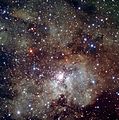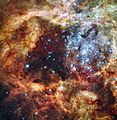Super star cluster facts for kids
Super star clusters are like giant nurseries for baby stars! They are huge groups of very young, very large stars. Scientists think these clusters might eventually grow up to become something called globular clusters, which are even older and more tightly packed groups of stars.
The stars in super star clusters are often blue, super hot, and don't live very long. They give off a lot of powerful UV energy. This energy makes the gas around them glow brightly, like a cosmic neon sign!
You can find super star clusters in our own Milky Way galaxy, like Westerlund 1 and Westerlund 2. Another famous one is R136, which is located in a nearby galaxy called the Large Magellanic Cloud. Even smaller galaxies, like NGC 1569, can have two of these amazing star factories.
Contents
What Makes a Super Star Cluster Special?
Super star clusters are unique because they are incredibly dense and full of massive stars. Imagine a city where every building is a skyscraper, and they're all built very close together – that's a bit like a super star cluster!
How Do They Form?
These clusters form in areas where there's a lot of gas and dust. Gravity pulls all this material together, and when it gets dense enough, new stars begin to ignite. Because there's so much material, many stars form at once, creating these giant clusters.
Why Are They Important to Study?
Studying super star clusters helps scientists understand how stars are born and how galaxies evolve. They are like living laboratories that show us what the early universe might have looked like when many stars were forming rapidly. They also help us learn about the life cycles of the biggest and brightest stars.
Famous Super Star Clusters
There are several well-known super star clusters that astronomers love to observe.
Westerlund 1
Westerlund 1 is one of the most massive and compact young star clusters in our Milky Way galaxy. It's home to some of the biggest and brightest stars we know! If it were closer to Earth, it would shine as brightly as the full Moon.
R136
R136 is located in the Tarantula Nebula, a huge star-forming region in the Large Magellanic Cloud. This cluster contains some of the most massive stars ever discovered, with some weighing over 100 times the mass of our Sun! These giant stars are incredibly hot and bright.
Images for kids
See also
 In Spanish: Supercúmulo estelar para niños
In Spanish: Supercúmulo estelar para niños





